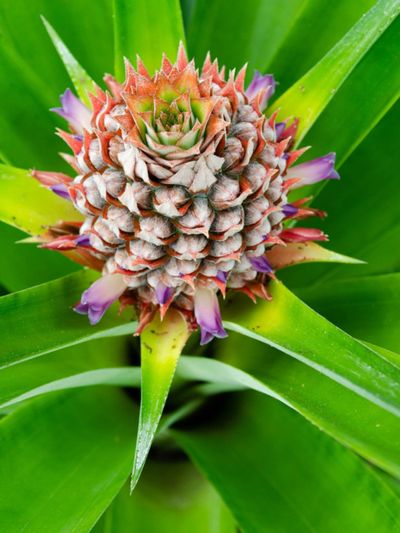The pineapple flowering houseplant is a bromeliad and requires similar care. Care for the variegated pineapple is the same as an edible pineapple, but don’t expect fruiting overnight. Both types can take up to five years to produce fruit.
Pineapple Bromeliad Varieties
Bromeliads are a family of sometimes stemless, sometimes epiphytic plants. They may also be grown in an almost soil-free environment made up of other materials such as sand, peat, and bark. Bromeliads are common in warm areas with high humidity. There are hundreds of varieties of pineapple. Not all of them produce a yellow fleshed fruit armored in green. There are also red and blue varieties. The best pineapple bromeliad varieties for home growers are the miniature types. These plants are easier to keep to container size, so you can move them in and protect them in case of freezing weather.
Variegated Pineapple Plant
Pineapples are only hardy in USDA zones 10 to 11. These warm season plants can be grown inside as striking houseplants. The variegated form is colorful and lively, well suited for a partially sunny room. Growing variegated pineapples in full sun is not recommended as the best color comes in lower light areas. The plant is a novelty plant and not as easy to find as the regular pineapple bromeliad varieties. Mature plants can produce a flower within a year of planting. To start your own pineapple flowering houseplant, harvest a fruit and cut the top off. Let the top dry on the counter for a day or two. Plant the base in a mixture of orchid bark and sand that is lightly moist. Keep somewhat moist until the top roots, taking care not to overwater, which will make the fruit top rot. You can also remove any offsets and plant them. Let these root and you will soon be growing variegated pineapples to share with friends and family.
Care for Variegated Pineapple
Pineapples require medium light, soil low in organic amendments, and moderate moisture. The plant can tolerate short periods of drought with no ill effects. They can be prone to several pests including aphids, whiteflies, and scale. Rinse off soft bodied pests and use a horticultural soap to combat the others. Fertilize every two weeks in spring until dormancy in fall. Use a diluted liquid plant fertilizer. Water thoroughly each time, but allow the surface of the soil to dry out before applying more water. Variegated pineapple plant must be kept where temperatures are between 65 and 82 degrees F. (18-28 C.) with high humidity for best growth. Mimic the growing conditions of a Hawaiian island and you are guaranteed success with your pineapple flowering houseplant!
